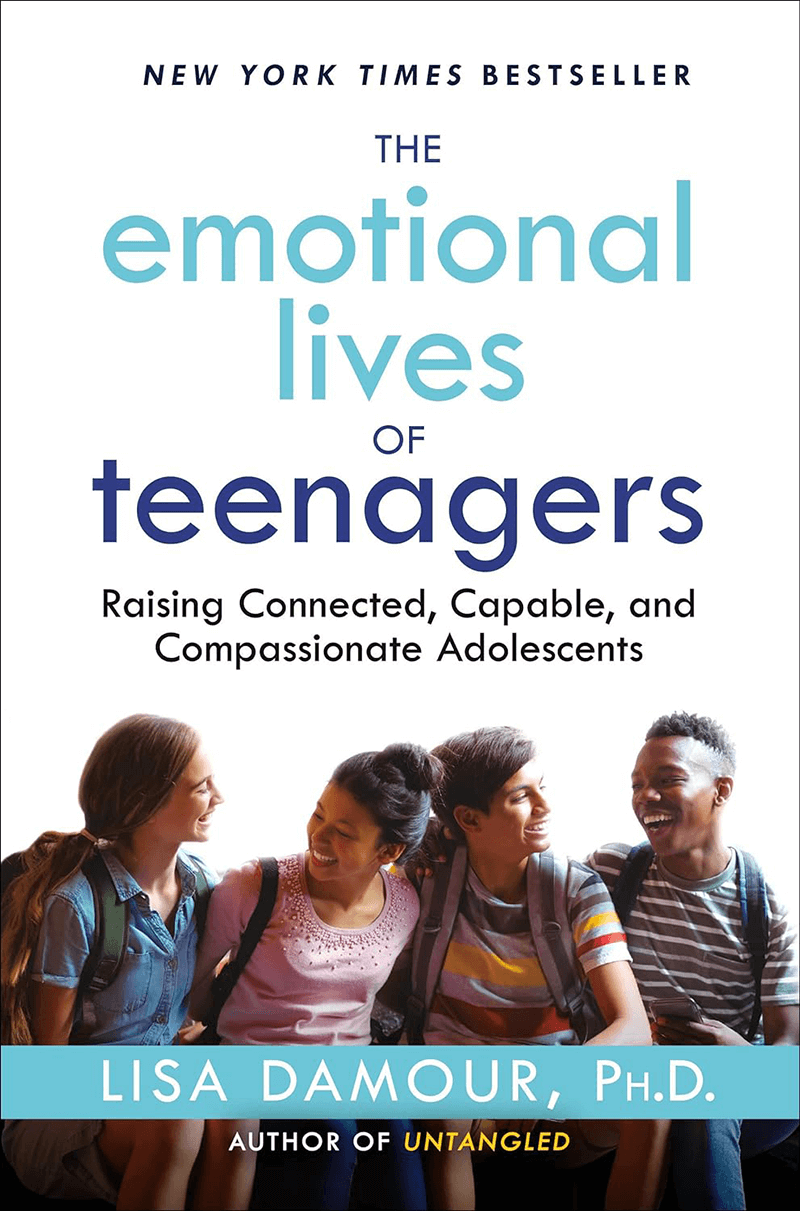
The Emotional Lives of Teenagers: Raising Connected, Capable, and Compassionate Adolescents
by Lisa Damour
Ballantine Books, 2023, $28; 256 pages.
As reviewed by Elaine Griffin
For latchkey kids like me growing up in the 1980s, teenage angst was a collective character trait. Popular songs like “Don’t You (Forget about Me)” by Simple Minds or “Should I Stay or Should I Go” by The Clash channeled our moodiness and insecurities. Movies like Footloose and Ferris Bueller’s Day Off explored teenagers’ rebellious instincts while their parents were off-screen and out of the loop. Growing up is hard, the entertainment industry told us, and our experiences confirmed that.
In 2023, kids are being schooled by the wellness industry, which now represents a larger segment of the global economy than the entertainment industry. These young people should have a much better chance of growing up happy than we did. But do they? And is it possible that the pursuit of happiness is itself part of the problem?
 In her insightful new book, The Emotional Lives of Teenagers, clinical psychologist Lisa Damour argues that the wellness industry has contributed to a new cultural norm that simply isn’t sound or even useful: it has equated feeling good with mental health. The result, Damour asserts, is that we are “afraid of being unhappy.” In Damour’s practice, teens who are not feeling calm, relaxed, or happy confess to “failing at wellness.”
In her insightful new book, The Emotional Lives of Teenagers, clinical psychologist Lisa Damour argues that the wellness industry has contributed to a new cultural norm that simply isn’t sound or even useful: it has equated feeling good with mental health. The result, Damour asserts, is that we are “afraid of being unhappy.” In Damour’s practice, teens who are not feeling calm, relaxed, or happy confess to “failing at wellness.”
Under the influence of the wellness industry, educators have incorporated meditation, yoga, and gratitude journals into their curricula to support the wellbeing of their students, many of whom say they are anxious or depressed. Damour acknowledges that many mindfulness practices are valuable, but she cautions against thinking that they can lead to happiness or prevent negative feelings. Her reflections instead suggest that educators need to help students understand the nature of wellness as practices, not goals.
Making happiness the goal of a wellness routine is like teaching to the test: it becomes a means to an end that risks degrading the experience itself. We should expand our students’ understanding of their emotional lives and the surrounding world—using both wellness and traditional pedagogical practices—rather than focusing their attention on an illusory goal like “happiness.” By teaching kids to revel in the process of learning about their bodies, their minds, and the world, we expand their ability to accept emotions that will necessarily include the bitter and the sweet, the lows as well as the highs. In short, we should expand students’ sense of all it means to be fully human, in which the questions and uncertainties matter as much as the answers.
The social media outlets through which teens receive a lot of their mental health information promote a much more prescriptive, ends-oriented understanding of the good life. Self-proclaimed experts pedal happiness hacks or self-care products with the promise that using them will produce a kind of emotional equilibrium. Damour points out that by investing in self-care—and the accompanying goods and services—kids believe that they can prevent anxiety and emotional distress. But losing a big game, doing poorly on a test, or getting dumped are not only distressing, they are also fairly common experiences among adolescents. Damour fears that “the wellness movement has left parents and their teens unduly frightened of garden variety adversity” and therefore unable to appreciate how much we grow through failure and hardship.
Ironically, despite growing up in a wellspring of wellness information, teens today feel worse than ever.
But the wellness industry is just one factor. The Covid-19 pandemic also contributed to the rise in depression and anxiety among young people by stymieing opportunities for social engagement, Damour says. She also speculates that the plethora of prescription medication available to stave off emotional discomfort may make teens view the daily ups and downs that accompany growing up “as something that can be deterred or contained with chemical interventions.”
Damour offers a useful corrective to the idea that mental health means feeling good. She believes that context is everything, that mental health means “having the right feelings at the right time.” If a teen fails a math test, they should feel disappointment. If they score a winning goal, they should feel a sense of pride. Healthy people experience the full range of human emotions and can identify and name them.
Teenagers feel emotions more acutely than the rest of us, so dealing with difficult emotions may be particularly painful to them. Damour explains how the teenage brain amplifies emotions; strong emotions “are a feature, not a bug” in their neurological wiring. During adolescence, the emotion centers of the brain strengthen and predominate the portions of the brain that help maintain a measured perspective. This “emotional intensity actually peaks around age thirteen or fourteen” and begins to subside after that.
So, how can parents support their children through this rocky period of development? Damour’s book provides a lot of practical advice to parents on how to create more harmonious relationships with their teens.
I couldn’t help thinking, as I read her advice, that she was presenting an unattainable ideal. So don’t try to hold yourself up to the standards set by this world-renowned child psychologist. Damour’s scripted accounts of dealing with teenagers exemplify the calm and logic a professional would display in one’s clinical practice.
What Damour does best is put the phases of growing up into perspective, showing that parents’ uncomfortable exchanges with their teens have less to do with their parenting style and more to do with adolescent development.
For example, it’s helpful to know that adolescents, usually around age 13, go through something psychologists call “separation-individuation.” Damour muses that this phase should be called “the several months when your teenager can’t stand how you chew.” Damour explains that healthy adolescents need to separate from their parents and become increasingly independent. To do so, they develop their own “brand identity,” one that is intentionally distinct from their parents’ brand. Suddenly, Mom’s outfit is out of style, Dad’s car is embarrassing, and both of them listen to music that could only be characterized as geriatric (you know, like Simple Minds or The Clash).
Rest assured that this is a short and necessary stage through which teens pass on the road to independence. I had a middle school parent tell me that when her daughter criticizes her, her husband soothes his wife by saying, “It’s the hormones; they’ve poisoned her.” While Damour’s book focuses on brain development rather than hormones, the larger point remains: a teen’s outburst is “a lot less personal than it feels.” When parents are on the receiving end of harsh criticism, the author advises, they should “try to engage as little as possible.”

After reading Damour’s book, I asked her how parents might deal productively with kids as they move through this challenging phase. “To me,” she wrote, “it seems fair to tell teens that they can’t be unkind or rude. They can, however, say that they need some space.”
How can you engage positively with your teen when they are suffering and need support processing emotions? Damour gives advice that I hope will bring you relief.
Don’t swoop in and try to fix everything. Doing so won’t allow teens the opportunity to manage their emotions and develop problem-solving skills. No need to be heroic; just hone your listening skills. There is solid evidence that active listening may be all that is needed to help your child with emotional regulation.
When kids put their problems into words, they gain perspective and insight; even just speaking about their experience connects them with another person. To really listen, Damour asks parents to imagine that they are a newspaper editor who is trying to come up with a headline about the story a reporter is narrating to them. Rather than offering feedback, a headline that summarizes the story goes a long way toward making a teen feel seen and heard. When I listen to middle schoolers explain their problems to me at school, I usually provide a brief summary of what I’ve heard, starting with, “Let me see if I’ve got this right. . . .” An empathetic summing-up is often all the student needs to feel better and head back to class.
At times, however, parents and teachers aren’t dealing with highly verbal kids. Some students don’t have robust vocabularies, perhaps because they read only what is assigned for school. We are also seeing a rise in neurodivergent students, some of whom have language processing issues. When I asked Damour how we can better support these students, she said that we should “spend dedicated time expanding teens’ vocabularies for describing emotion. This can happen through direct instruction—such as when talking about the books they’ve been assigned at school—and also during interactions with teens, such as when they describe an emotion in generic terms and we respond empathically by offering a more precise word for what they are feeling.”
The importance of expanding students’ emotional vocabularies resonated with me as a middle school head who cares deeply about my students’ social and emotional development. When students share that they feel “bad,” we have very little information. They could be disheartened, apprehensive, or frustrated—three very distinct feelings—but they haven’t developed the emotional vocabulary to label their feelings accurately.
But when students can identify and articulate their feelings, they can respond proportionately and make a plan to manage them. Classroom discussions of short stories or films could support educators’ work in this area. Characters who have the right feelings at the right time illuminate and normalize the wide range of human emotions. More important, talking about characters rather than themselves allows teens a safe way to explore difficult emotions, such as sadness, anger, or shame.
For teens who just aren’t talkers, there are other methods one can employ to help them manage their feelings. Damour suggests that parents encourage their verbally reticent adolescents to channel their emotions through physical activities, like going for a run, or through more passive experiences, like listening to “mood-matching music.” Distraction is also a good way to provide some relief for intense emotions. A short stint of video-game playing may be just what a teen needs to forget about a mean group text they just read.
In the end, Damour’s advice all comes back to showing compassion. Teens are going to experience extreme highs and lows; by modeling calm and composure, parents and educators alike can do a lot to provide a steadying presence.
As I read this book, I wrote three times in the margins, “Who’s taking care of the caretaker?” In one anecdote, a mother seeks out Damour for advice when her teenage daughter becomes increasingly critical of her. The mother shared that when her daughter was expecting some friends to visit the house, she told her mother that her shirt was “dumpy” and asked her to relocate before her friends arrived and saw her. I couldn’t help but pause and think how hurtful it must have been to be on the receiving end of that comment.
So, let me add my own advice to parents and teachers of teens, based on a long career as a teacher and school administrator: be good to yourself.
Whether as a parent or as an educator, you work hard to provide a caring and stable environment for the adolescents in your life. Take some of Damour’s advice for teens and practice it yourselves. Get sufficient sleep, make time for exercise, and talk to someone who really listens to you, so that you can be your best self. Show yourself some compassion, too. You deserve that for all that you are doing to build better teens, better families, and better schools for a better future.
Elaine Griffin is the head of middle school at University School of Milwaukee.
This article appeared in the Winter 2024 issue of Education Next. Suggested citation format:
Griffin, E. (2024). Right Feelings,Right Time: The emotional life of a teenager is hard to navigate—for parents and teachers, too. Education Next, 24(1), 83-85.


